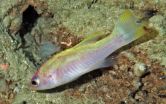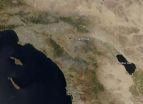(Press-News.org) Imagine a future in which our electrical gadgets are no longer limited by plugs and external power sources.
This intriguing prospect is one of the reasons for the current interest in building the capacity to store electrical energy directly into a wide range of products, such as a laptop whose casing serves as its battery, or an electric car powered by energy stored in its chassis, or a home where the dry wall and siding store the electricity that runs the lights and appliances.
It also makes the small, dull grey wafers that graduate student Andrew Westover and Assistant Professor of Mechanical Engineering Cary Pint have made in Vanderbilt's Nanomaterials and Energy Devices Laboratory far more important than their nondescript appearance suggests.
"These devices demonstrate – for the first time as far as we can tell – that it is possible to create materials that can store and discharge significant amounts of electricity while they are subject to realistic static loads and dynamic forces, such as vibrations or impacts," said Pint. "Andrew has managed to make our dream of structural energy storage materials into a reality."
That is important because structural energy storage will change the way in which a wide variety of technologies are developed in the future.
"When you can integrate energy into the components used to build systems, it opens the door to a whole new world of technological possibilities. All of a sudden, the ability to design technologies at the basis of health, entertainment, travel and social communication will not be limited by plugs and external power sources," Pint said.
The new device that Pint and Westover has developed is a supercapacitor that stores electricity by assembling electrically charged ions on the surface of a porous material, instead of storing it in chemical reactions the way batteries do. As a result, supercaps can charge and discharge in minutes, instead of hours, and operate for millions of cycles, instead of thousands of cycles like batteries.
In a paper appearing online May 19 in the journal Nano Letters, Pint and Westover report that their new structural supercapacitor operates flawlessly in storing and releasing electrical charge while subject to stresses or pressures up to 44 psi and vibrational accelerations over 80 g (significantly greater than those acting on turbine blades in a jet engine).
Furthermore, the mechanical robustness of the device doesn't compromise its energy storage capability. "In an unpackaged, structurally integrated state our supercapacitor can store more energy and operate at higher voltages than a packaged, off-the-shelf commercial supercapacitor, even under intense dynamic and static forces," Pint said.
One area where supercapacitors lag behind batteries is in electrical energy storage capability: Supercaps must be larger and heavier to store the same amount of energy as lithium-ion batteries. However, the difference is not as important when considering multifunctional energy storage systems.
"Battery performance metrics change when you're putting energy storage into heavy materials that are already needed for structural integrity," said Pint. "Supercapacitors store ten times less energy than current lithium-ion batteries, but they can last a thousand times longer. That means they are better suited for structural applications. It doesn't make sense to develop materials to build a home, car chassis, or aerospace vehicle if you have to replace them every few years because they go dead."
Westover's wafers consist of electrodes made from silicon that have been chemically treated so they have nanoscale pores on their inner surfaces and then coated with a protective ultrathin graphene-like layer of carbon. Sandwiched between the two electrodes is a polymer film that acts as a reservoir of charged ions, similar to the role of electrolyte paste in a battery. When the electrodes are pressed together, the polymer oozes into the tiny pores in much the same way that melted cheese soaks into the nooks and crannies of artisan bread in a Panini. When the polymer cools and solidifies, it forms an extremely strong mechanical bond.
"The biggest problem with designing load-bearing supercaps is preventing them from delaminating," said Westover. "Combining nanoporous material with the polymer electrolyte bonds the layers together tighter than superglue."
The use of silicon in structural supercapacitors is best suited for consumer electronics and solar cells, but Pint and Westover are confident that the rules that govern the load-bearing character of their design will carry over to other materials, such as carbon nanotubes and lightweight porous metals like aluminum.
The intensity of interest in "multifunctional" devices of this sort is reflected by the fact that the U.S. Department of Energy's Advanced Research Project Agency for Energy is investing $8.7 million in research projects that focus specifically on incorporating energy storage into structural materials. There have also been recent press reports of several major efforts to develop multifunctional materials or structural batteries for use in electric vehicles and for military applications. However, Pint pointed out that there have not been any reports in the technical literature of tests performed on structural energy storage materials that show how they function under realistic mechanical loads.
INFORMATION:
Amrutur Anilkumar, professor of the practice in mechanical engineering, postdoctoral associate Shahana Chatterjee, graduate student Landon Oakes, undergraduate mechanical engineering majors John Tian, Shivaprem Bernath and Farhan Nur Shabab and high school student Rob Edwards collaborated in the project.
The research was supported by National Science Foundation grants CMMI 1334269 and EPS 104083. Materials fabrication was conducted in part at the Center for Nanophase Materials Sciences at Oak Ridge National Laboratory that is supported by the Office of Basic Energy Sciences of the U.S. Department of Energy.
Visit Research News @ Vanderbilt for more research news from Vanderbilt. [Media Note: Vanderbilt has a 24/7 TV and radio studio with a dedicated fiber optic line and ISDN line. Use of the TV studio with Vanderbilt experts is free, except for reserving fiber time.]
Liberating devices from their power cords
New structural 'supercaps' take a lickin', keep on workin'
2014-05-19
ELSE PRESS RELEASES FROM THIS DATE:
Having and raising offspring is costly phase of life for baboon moms
2014-05-19
Observations made over the past 29 years in Kenya as part of one of the world's longest-running studies of a wild primate show how having offspring influences the health of female baboons. These observations highlight that females are mostly injured on days when they are likely to conceive. In addition, injuries heal the slowest when they are suckling their young. The study, published in Springer's journal Behavioral Ecology and Sociobiology, is led by Elizabeth Archie of the University of Notre Dame in the US and the National Museums of Kenya.
Reproduction can be dangerous ...
UT Dallas lab eliminates rare metals in electric motors
2014-05-19
A team from the Renewable Energy and Vehicular Technology Laboratory(REVT) at UT Dallas was one of a few research groups selected for advanced participation in a Department of Energy conference aimed at presenting the next generation of energy technologies.
The DOE's Advanced Research Projects Agency-Energy (ARPA-E) program hosts an annual summit in Washington, D.C., for researchers, entrepreneurs, investors, corporate executives and government officials to share transformational research funded through the program.
Dr. Babak Fahimi, professor of electrical engineering ...
Genes play key role in brain injury risk for premature babies
2014-05-19
Premature babies' risk of brain injury is influenced by their genes, a new study suggests.
Researchers have identified a link between injury to the developing brain and common variation in genes associated with schizophrenia and the metabolism of fat.
The study builds on previous research, which has shown that being born prematurely – before 37 weeks – is a leading cause of learning and behavioural difficulties in childhood.
Around half of infants weighing less than 1500g at birth go on to experience difficulties in learning and attention at school age.
Scientists ...
Engineers find way to lower risk of midair collisions for small aircraft
2014-05-19
Researchers at North Carolina State University have developed new modifications for technology that helps pilots of small aircraft avoid midair collisions. The modified tools significantly improved pilot response times in making decisions to avert crashes.
At issue are "cockpit displays of traffic information" (CDTIs). These are GPS displays used by private pilots to track other aircraft in their vicinity. However, pilots often focus on the closest aircraft on the display – a habit that can pose a significant hazard.
If the pilot of Plane A sees two planes on the CDTI, ...
How octopuses don't tie themselves in knots revealed by Hebrew University scientists
2014-05-19
An octopus's arms are covered in hundreds of suckers that will stick to just about anything, with one important exception: those suckers generally won't grab onto the octopus itself, otherwise the impressively flexible animals would quickly find themselves all tangled up.
Now, researchers from the Hebrew University of Jerusalem report that they discovered how octopuses manage this feat, even as the creatures' brains are unaware of what their arms are doing. A chemical produced by octopus skin temporarily prevents their suckers from sucking.
"We were surprised that ...
The spot-tail golden bass: A new fish species from deep reefs of the southern Caribbean
2014-05-19
Smithsonian scientists describe a colorful new species of small coral reef sea bass from depths of 182–241 m off Curaçao, southern Caribbean. With predominantly yellow body and fins, the new species, Liopropoma santi, closely resembles the other two "golden basses" found together with it at Curaçao: L. aberrans and L. olneyi.
The scientists originally thought there was a single species of golden bass on deep reefs off Curaçao, but DNA data, distinct color patterns, and morphology revealed three. The study describing one of those, L. santi—the deepest known species of ...
Neutron beams reveal how antibodies cluster in solution
2014-05-19
Scientists have used small-angle neutron scattering (SANS) and neutron spin-echo (NSE) techniques for the first time to understand how monoclonal antibodies (mAbs), a class of targeted biopharmaceuticals used to treat autoimmune disorders and cancer, dynamically cluster and move in high concentration solutions. Certain mAb cluster arrangements can thicken pharmaceutical solutions; they could thus limit the feasible concentration of injectables administered to patients around the world. The insights provided by a team of neutron scientists from the National Center of Neutron ...
San Diego county fires still rage
2014-05-19
The San Diego County fires that began on Wednesday May 14 as a single fire that erupted into nine fires that burned out of control for days. According to News Channel 8, the ABC affiliate in San Diego, the following summarizes what the current conditions are for the fires still left burning:
"Cocos Fire - San Marcos: This fire has burned 1,995 acres and is 87 percent contained Monday morning. All evacuation orders and road closures were lifted as of 11 a.m. Sunday, according to the City of San Marcos.
San Mateo Fire - Camp Pendleton: The San Mateo Fire that was reported ...
New technique to prevent anal sphincter lesions due to episiotomy during child delivery
2014-05-19
Results of a 10-year long multinational research project on Technologies for Anal Sphincter analysis and Incontinence (TASI) are available in:
Corrado Cescon, Diego Riva , Vita Začesta, Kristina Drusany-Starič, Konstantinos Martsidis,
Olexander Protsepko, Kaven Baessler, Roberto Merletti
Effect of vaginal delivery on the external anal sphincter muscle innervation pattern evaluated by multichannel surface EMG: results of the multicentre study TASI-2
International Urogynecology Journal, DOI 10.1007/s00192-014-2375-0.
Episiotomy is a controversial surgical ...
Studies published in NEJM identify promising drug therapies for fatal lung disease
2014-05-19
LOS ANGELES (May 18, 2014) – Researchers in separate clinical trials found two drugs slow the progression of idiopathic pulmonary fibrosis, a fatal lung disease with no effective treatment or cure, and for which there is currently no therapy approved by the Food and Drug Administration.
Paul W. Noble, MD, chair of the Department of Medicine at Cedars-Sinai and director of the Women's Guild Lung Institute, is the senior author of the multicenter study that found that the investigational drug pirfenidone significantly slowed the loss of lung function and reduced the ...
LAST 30 PRESS RELEASES:
Why nail-biting, procrastination and other self-sabotaging behaviors are rooted in survival instincts
Regional variations in mechanical properties of porcine leptomeninges
Artificial empathy in therapy and healthcare: advancements in interpersonal interaction technologies
Why some brains switch gears more efficiently than others
UVA’s Jundong Li wins ICDM’S 2025 Tao Li Award for data mining, machine learning
UVA’s low-power, high-performance computer power player Mircea Stan earns National Academy of Inventors fellowship
Not playing by the rules: USU researcher explores filamentous algae dynamics in rivers
Do our body clocks influence our risk of dementia?
Anthropologists offer new evidence of bipedalism in long-debated fossil discovery
Safer receipt paper from wood
Dosage-sensitive genes suggest no whole-genome duplications in ancestral angiosperm
First ancient human herpesvirus genomes document their deep history with humans
Why Some Bacteria Survive Antibiotics and How to Stop Them - New study reveals that bacteria can survive antibiotic treatment through two fundamentally different “shutdown modes”
UCLA study links scar healing to dangerous placenta condition
CHANGE-seq-BE finds off-target changes in the genome from base editors
The Journal of Nuclear Medicine Ahead-of-Print Tip Sheet: January 2, 2026
Delayed or absent first dose of measles, mumps, and rubella vaccination
Trends in US preterm birth rates by household income and race and ethnicity
Study identifies potential biomarker linked to progression and brain inflammation in multiple sclerosis
Many mothers in Norway do not show up for postnatal check-ups
Researchers want to find out why quick clay is so unstable
Superradiant spins show teamwork at the quantum scale
Cleveland Clinic Research links tumor bacteria to immunotherapy resistance in head and neck cancer
First Editorial of 2026: Resisting AI slop
Joint ground- and space-based observations reveal Saturn-mass rogue planet
Inheritable genetic variant offers protection against blood cancer risk and progression
Pigs settled Pacific islands alongside early human voyagers
A Coral reef’s daily pulse reshapes microbes in surrounding waters
EAST Tokamak experiments exceed plasma density limit, offering new approach to fusion ignition
Groundbreaking discovery reveals Africa’s oldest cremation pyre and complex ritual practices
[Press-News.org] Liberating devices from their power cordsNew structural 'supercaps' take a lickin', keep on workin'




